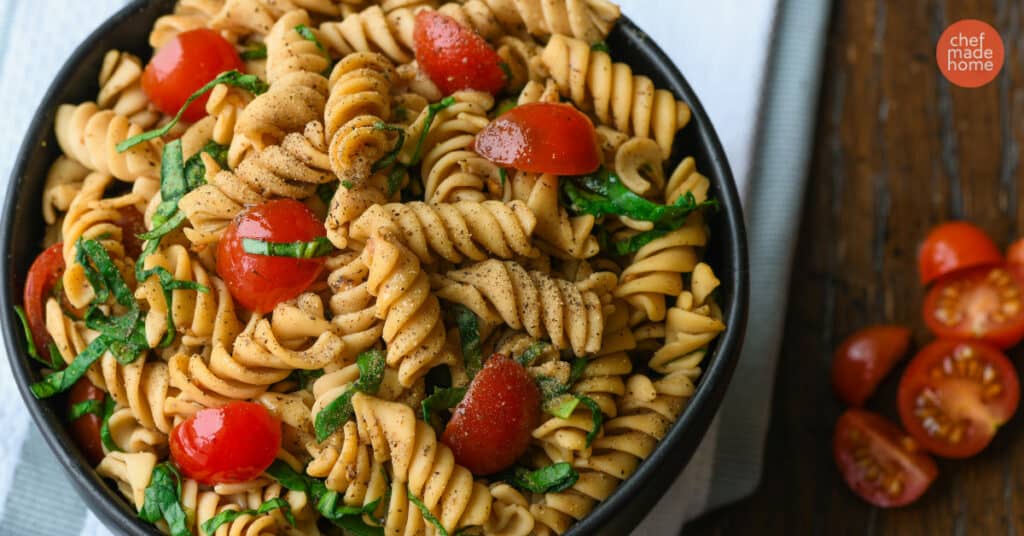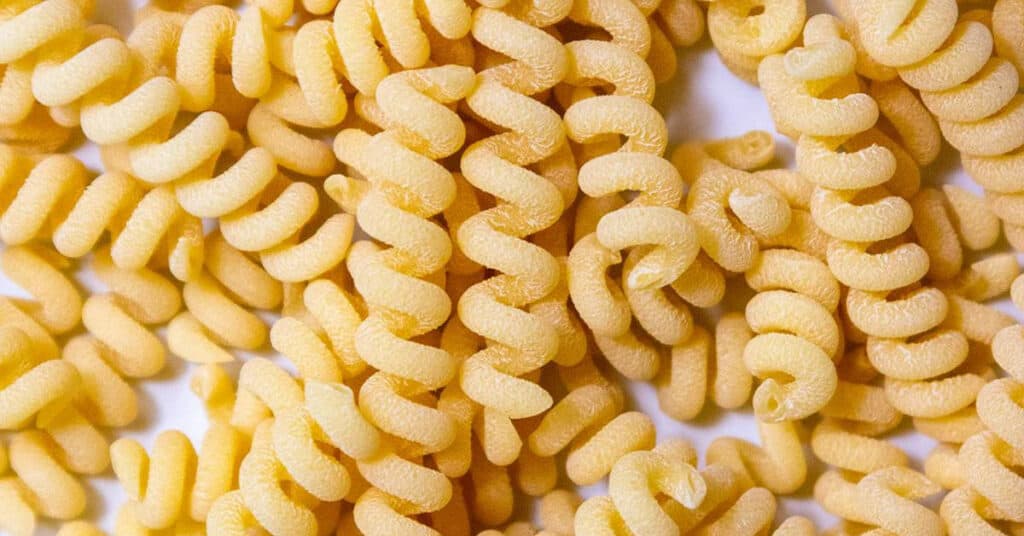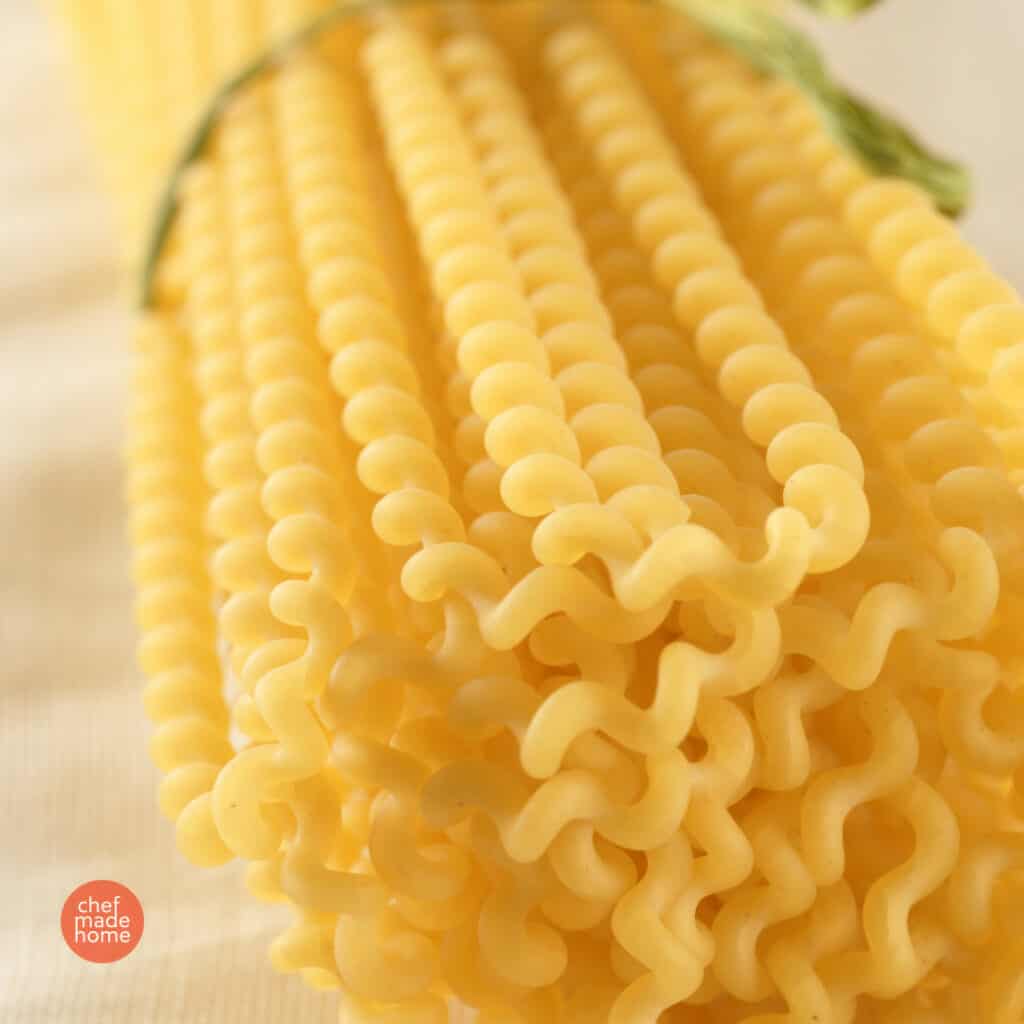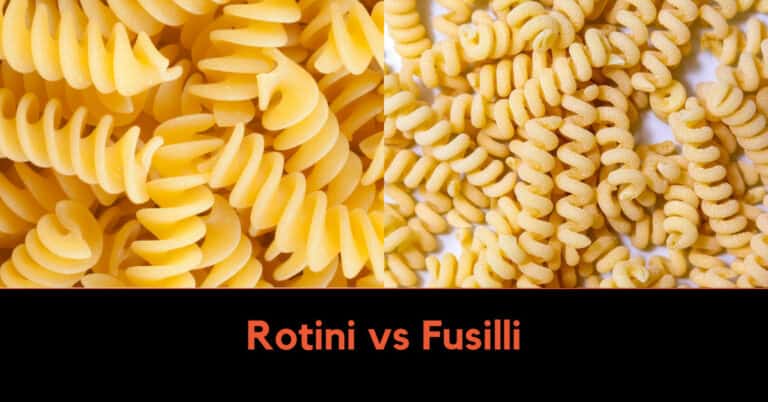**SUMMARY:** Rotini and fusilli are both popular types of pasta that differ in shape more than you realize. Rotini is spiral-shaped, while fusilli is corkscrew-shaped and rolled after extrusion, allowing for different textures and sauce adhesion.
Are you tired of getting stuck in a pasta rut? Which twisted pasta shape will take your dishes to the next level? Look no further! This article will delve into the tantalizing world of rotini and fusilli, comparing their unique attributes, flavors, and culinary applications. Get ready to unravel the mystery of these spiral wonders as we explore their textures, versatility, and much more:
- Explaining Rotini
- Unveiling Fusilli
- Comparing Rotini and Fusilli
- The Verdict
Let’s begin this flavorful journey and end the age-old debate of rotini versus fusilli.
Explaining Rotini

Rotini, also known as corkscrew pasta, is a unique and beloved member of the pasta family. Here’s everything you need to know about this delightful twist:
Shape and Texture
- Aesthetically pleasing, rotini boasts a helix-like shape resembling a spring.
- Its tightly wound coils and spirals create a delightful and functional texture.
- The ridges and grooves of rotini hold onto sauces and flavors, making it a perfect choice for hearty dishes.
Origins and Heritage
- Rotini finds its roots in Italy, the pasta paradise.
- Inspired by the natural spiral patterns, rotini aims to replicate the beauty of tornadoes and whirlpools.
- While traditionally made with durum wheat, modern variations come in various colors and flavors.
Versatility in the Kitchen
- Rotini works wonders in cold and warm dishes, making it versatile in any culinary repertoire.
- Its shape showcases sauces and dressings, elevating pasta salads to a new level.
- Its sturdy form ensures it holds well in baked dishes, enticingly capturing flavors and complementing other ingredients.
So, now that we’ve untangled the mysteries of rotini get ready to dive into the seductive world of fusilli in the next section!
Unveiling Fusilli

Fusilli is a classic pasta shape that pasta enthusiasts have loved and enjoyed for centuries. Known for its spiral-shaped design, fusilli brings a delightful twist to your pasta dishes. Originating from Southern Italy, this pasta variety has made its way into the hearts and kitchens of people worldwide. Here’s everything you need to know about this enchanting pasta:
Shape and Texture:
- Fusilli is characterized by its distinctive corkscrew or helix shape, which resembles a spring or spiral staircase.
- The coils of fusilli are not only visually appealing but also serve a practical purpose, as they effectively trap sauces, spices, and flavorings.
- With its tightly wound structure, fusilli holds onto sauces, ensuring every bite is bursting with the perfectly balanced combination of pasta and sauce.
Origin and History:
- Fusilli is deeply embedded in Italian culinary traditions like many other pasta shapes.
- It originated in Southern Italy, where pasta making is an art passed down through generations.
- The name “fusilli” is derived from the Italian word “fuso,” meaning “spindle” or “coil.”
- Throughout history, fusilli has been a popular choice in Italian households. It is appreciated for its versatility and ability to hold robust, chunky sauces.
Unique Qualities:
- Fusilli’s spiral shape enhances its presentation and contributes to its distinctive texture.
- The ridges and grooves on the pasta’s surface yield a satisfying mouthfeel, ensuring a delightful taste experience.
- Due to its shape and texture, fusilli pairs exceptionally well with various sauces, including tomato-based, cream-based, and oil-based options.
- The crevices of fusilli make it ideal for holding onto chunky ingredients like vegetables, meat, and cheese, evenly distributing flavors throughout the dish.
Now that we’ve explored fusilli’s unique qualities and characteristics, let’s move on to the next section, where we’ll compare rotini and fusilli side by side.
Comparing: Rotini vs Fusilli
Regarding pasta options, both rotini and fusilli offer unique qualities that can elevate your culinary creations. Let’s take a closer look at how these two pasta varieties compare:
Taste and Texture:
- Rotini:
- With its spiral shape, rotini provides a satisfying texture that holds up well when cooked.
- The rotini’s slightly twisted ridges help trap sauces and flavors, resulting in a harmonious blend of pasta and toppings.
- In terms of taste, rotini is versatile, complementing a wide range of sauces, from light and creamy to bold and chunky.
- Fusilli:
- Similarly, fusilli boasts a delightful texture from its spiral and elongated shape.
- The ridged surface of fusilli is adept at collecting and holding sauces, allowing for a more intense and flavorful eating experience.
- Regarding taste, fusilli delivers a slightly nuanced profile that pairs exceptionally well with sauces featuring robust ingredients like garlic, olive oil, and fresh herbs.
Suitability for Different Recipes:
- Rotini:
- Due to its sturdy and compact structure, rotini is a versatile choice that performs well in various dishes.
- The ridges and twists of rotini make it an excellent option for chunky and meaty sauces, as it can hold and distribute the ingredients evenly throughout the dish.
- Additionally, rotini’s shape makes it a popular choice for pasta salads and casseroles, as it can retain its texture even after being cooked and chilled.
- Fusilli:
- Fusilli’s unique shape and texture lend itself well to dishes that marry various flavors and ingredients.
- Its ability to hold onto sauces and toppings makes fusilli ideal for hearty and robust pasta dishes, such as baked pasta bakes, pasta with ragu, or pasta tossed with pesto.
- The spring-like shape of fusilli also allows it to pair beautifully with lighter sauces, such as lemon and olive oil, as it captures and distributes the flavors with precision.
Cooking and Preparation Preferences:
- Rotini:
- Rotini typically cooks within 8-10 minutes, depending on the desired level of tenderness.
- Adding sufficient salt to the boiling water is essential to enhance the flavor of rotini.
- As with any pasta, ensuring that the water is boiling vigorously before adding the rotini is crucial to prevent the pasta from becoming sticky or clumpy.
- Fusilli:
- Fusilli follows a cooking time similar to the rotini, usually 8-10 minutes.
- Like rotini, fusilli benefits from well-seasoned cooking water, allowing the pasta to absorb some salt.
- To prevent the spiral-shaped pasta from clumping together during cooking, gently stirring it shortly after adding it to boiling water can help.
With these comparisons in mind, it’s evident that rotini and fusilli offer unique characteristics that cater to various preferences and recipe requirements. Ultimately, the choice between the two will depend on the specific dish you plan to create.
In the next section, we will provide a verdict based on taste, texture, versatility, and popularity, helping you decide which pasta type reigns supreme.
The Verdict
After carefully considering the taste, texture, versatility, and popularity of rotini and fusilli pasta, it’s time to uncover the ultimate winner. While both pasta varieties offer unique qualities, one ultimately stands out as the superior choice. Here’s the verdict:
- Taste and Texture:
- Rotini’s textured ridges and slightly twisted shape deliver a pleasant and robust eating experience.
- Fusilli’s spiral design and ridged surface create a mouthwatering combination of taste and texture that holds sauces exceptionally well.
- Versatility:
- Rotini’s compact shape and sturdy structure make it a versatile option that works well in various dishes, including salads, casseroles, and more.
- Fusilli’s spiral shape and ability to capture flavors suit dishes featuring bold, chunky sauces and lighter, oil-based sauces.
- Popularity:
- With its recognizable shape and widespread availability, Rotini has become a staple in pantries and restaurants worldwide.
- Fusilli, beloved for its aesthetic appeal and ability to enhance sauces, has gained popularity among pasta enthusiasts seeking a unique dining experience.
Based on these factors, the crown for the superior pasta goes to…
Fusilli!

With its captivating spiral shape, delightful texture, and superb sauce-holding capabilities, fusilli emerges as the winner in this rotini vs. fusilli showdown. While rotini certainly holds its own in terms of versatility and popularity, fusilli’s distinct qualities and ability to elevate simple and elaborate pasta dishes make it a standout choice.
Now that you have the verdict, I encourage you to try rotini and fusilli. Experiment with different recipes and sauces to fully appreciate the unique attributes each pasta brings to the table. Whether you prefer rotini’s dependable versatility or fusilli’s artistry and flavor, your culinary adventures are guaranteed to be anything but ordinary.
Key Takeaways
After carefully evaluating and comparing rotini and fusilli, it is clear that both pasta types have unique qualities and characteristics. Here are the key takeaways from this article:
- Rotini is a spiral-shaped pasta with a slightly chewy texture, originating from Italy. It is highly versatile and can be used in various dishes, from salads to casseroles.
- On the other hand, Fusilli features twisted, corkscrew-like shapes, offering a delightful texture and playful appearance. It originates from Italy and is known for its ability to hold sauces well.
- In terms of taste, rotini tends to have a more substantial bite. At the same time, fusilli’s shape allows it to capture and hold onto the flavors of sauces and ingredients.
- Both rotini and fusilli are suitable for a wide range of recipes. Still, the choice between the two ultimately depends on personal preference and the specific dish being prepared.
- Regarding popularity, both pasta types are widely enjoyed and used by pasta enthusiasts and home cooks alike.
In conclusion, rather than declaring one pasta type superior to the other, it is important to recognize that rotini and fusilli each bring their unique qualities and attributes to the table. The best way to truly appreciate their distinct flavors and textures is to experiment with them in various recipes. So grab a box of rotini and fusilli, and let your taste buds be the judge!
FAQ Section
How do I cook rotini and fusilli?
Bring a pot of salted water to a rolling boil to cook rotini and fusilli. Add the pasta and cook according to package instructions, usually for about 8-10 minutes or until al dente. Once done, drain the pasta and rinse it with cold water to stop the cooking process.
What sauces go well with rotini and fusilli?
Both rotini and fusilli pair well with a variety of sauces. Rotini’s spiral shape makes it perfect for catching chunky sauces. At the same time, fusilli’s twists easily hold creamy and pesto-based sauces. Try them with a delicious combination of tomato-based sauces, creamy Alfredo, or even simple olive oil and garlic.
Can I use rotini or fusilli in baked pasta dishes?
Absolutely! Both rotini and fusilli are excellent choices for baked pasta dishes. Their shapes help to hold the sauce and other ingredients together, creating a flavorful and satisfying meal. Consider using them in casseroles, pasta bakes, or stuffed pasta recipes.
Are rotini and fusilli suitable for cold pasta salads?
Both rotini and fusilli are great options for cold pasta salads. Their shapes allow them to hold dressing and other ingredients well, ensuring a perfect blend of flavors. Add your favorite vegetables, proteins, and dressings to create a refreshing and tasty pasta salad.
Can rotini and fusilli be prepared in advance and reheated later?
Definitely! Rotini and fusilli can be cooked in advance, drained, and tossed with olive oil to prevent sticking. When ready to serve, simply reheat them gently in the microwave or on the stovetop, and they will be just as delicious as freshly cooked pasta.
Are rotini and fusilli suitable for vegan or gluten-free diets?
Both rotini and fusilli are available in gluten-free varieties, making them suitable for those following a gluten-free diet. Additionally, they can be incorporated into vegan dishes by pairing them with plant-based sauces and toppings. Always check the package labels to ensure they meet your dietary requirements.

